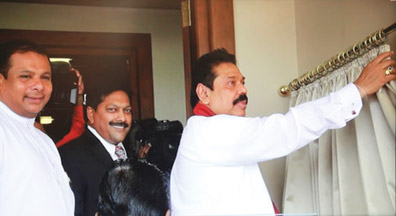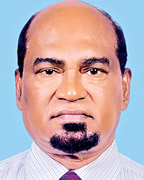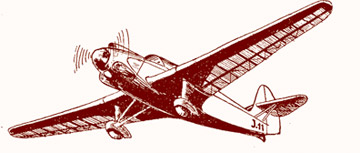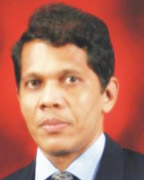Lanka has potential to be aviation hub in the region
By Shirajiv Sirimane
Sri Lanka recently celebrated the completion of one hundred years
since the commencement of aviation services. This coincided with a
landmark development in aviation-related infrastructure through the
construction and launch of the Mattala Rajapaksa International Airport
(MRIA). It is highly desirable at this juncture to find out the probable
potential the aviation industry holds for the overall economic growth of
Sri Lanka.
 |
|
The newly reconstructed
VVIP lounge of the BIA being opened by President Mahinda
Rajapaksa in October. Civil Aviation Minister Piyankara
Jayaratna and Chairman Airport and Aviation Services Prasanna J.
Wickramasuriya look on. |
The Government has identified aviation as a key economic growth area
and has taken policy decisions to promote the country as an aviation hub
in the region.
Sri Lanka's strategic geographical location, at a point where trade
routes cross each other from the West to the East and vice versa, has
been a consistent pattern from ancient times. The historic Silk Route,
connecting the East with the West, had crossed Sri Lanka. As a result,
there would have been plenty of transshipments routed via Sri Lanka even
then.
Although the island's strategic location offers great opportunity to
develop a key transshipment hub, this had not been harnessed for the
advancement of the economy.
The new infrastructure developments which have taken place such as
the international airport, the seaport and the highway system, combined
with the favourable geographic location, offer the country a great
opportunity to become an aviation hub, giving a big boost to the
economy.
New aviation business
 |
|
Lal Talgaswatte |
The MRIA and Hambantota Port are central projects of the recent
infrastructure development which have been constructed, investing large
sums of money and have to be gainfully used for the country’s economic
advancement.
Traditionally, Sri Lanka has been securing passenger and cargo
traffic through the Bandaranaike International Airport (BIA),
Katunayake, which has been expanded and developed in stages. However,
the BI A too has not reached its maximum potential and has room for
increased use.
Therefore, striving to make the MRIA economically viable by using
only the traditional aviation business experienced by Sri Lanka, both in
passenger and air cargo, is not desirable and is rather unrealistic.
It is imperative that Sri Lanka promotes new aviation business in
addition to the traditional passenger and air cargo traffic currently
enjoyed on its run-up to become an aviation hub.
There are many new potential businesses in aviation which Sri Lanka
can develop for the future, if it is to achieve hub status.
Multi-modal transportation

Arugam Bay, a popular tourist destination |

A leopard at the Yala Wildlife Park |
There are three modes of transportation - air, sea and surface or
road transportation. Passengers as well as goods sometimes use more than
one mode of transportation, according to Lal Talgaswatte, a veteran in
the aviation field with over 30 years experience in the airline
business.
The construction of the MRIA and Hambantota Port, the Southern
Expressway and Airport Expressway create a conducive system to promote
multi-modal transportation.
To make these facilities viable, it is pertinent that Sri Lanka
adopts an ‘out of the box’ approach in aviation business and capture new
market opportunities to bring in new business. It is important to look
in to the new aviation-related business which has the potential to boost
the country’s economic growth.
The two key infrastructure developments, the MRIA and Hambantota
Port, are close to each other, offering great opportunities to launch
new bimodal business using these facilities.
Apart from bimodal transportation, other aviation-related businesses
have the potential to catapult Sri Lanka to the aviation hub status,
Talgaswatte said. The following are key areas Sri Lanka needs to make a
concerted effort to promote if the country desires to achieve hub status
within a minimum time frame.
Cruising
At present, Sri Lanka is not such a popular destination for cruising.
However, being an island, it has all the requisites to become one.
SriLankan Airlines Chairman, Nishantha Wickremasinghe said European
tourists can land at Mattala, go over land to the East Coast within two
hours, do a round trip to the Cultural Triangle and Kandy and leave the
country from the BIA, after enjoying Colombo's shopping and other
attractions.
Cruising also can be considered as bimodal transportation, since the
first leg of the journey is by air and then by ship.
As a result of the MRIA and the Hambantota Port being situated only
20 kilometres apart, a great opportunity has arisen for Sri Lanka to
promote cruising. Passengers can be flown in to the MRIA and transferred
to the Port to embark on the cruising tour.
“Short duration cruising tours from two to three days from Colombo or
from Hambantota to Male or around the island or to Trincomalee/Oluvil
can be offered. Also, cruises from Hambantota can be arranged to South
Indian ports such as Cochin, Kerala which is popular with tourists,” he
said.
Sea/air cargo
Sea/air cargo is a key form of bimodal transportation, where cargo or
freight is carried by ship to an intermediate point and then switched or
transshipped as air carriage or vice versa.
Currently, a small volume of sea/air cargo is carried from Bangladesh
via Sri Lanka to Middle East/European countries. However, given the
geographically favourable location of Sri Lanka, coupled with the
transshipment facilities from the BIA to the Colombo Port, and from the
MRIA to the Hambantota Port and the highway linkage, it can play a vital
role in the development of sea/air cargo and business.
However, authorities should offer incentives pertaining to the
handling charges both at the MRIA and Hambantota Port.
For the country to become an air/sea hub, both air cargo and sea
freight capacity have to be expanded in and out of Sri Lanka.
The biggest opportunity for the country to expand air cargo capacity
is the MRIA.
If this manual/semi-automated airport can be positioned lower in
handling charges compared to the BIA and other airports in the region,
there will be a great opportunity to motivate the freighters, both
scheduled and charter operators to operate to the MRIA.
If large cargo carriers are attracted to the MRIA, small shipments
can be carried by air or sea from countries in the catchment area such
as India, Bangladesh, Pakistan and Vietnam and then consolidated at the
MRIA to be outbound as large shipments.
Low cost airlines
A key cost component which airlines have control over is the airport
handling charges. Low cost airlines always strive to operate to airports
which offer comparatively low handling charges, not mega airports
offering fully automated handling and other services. Most low cost
airports are either manually operated or have semi-automated operating
systems.
The MRIA can fit very well with the low cost handling requirement of
the low cost or no frills airlines. By operating to the MRIA, low cost
airlines would reduce their operational costs significantly.
A few low cost airlines operate to the BIA and some of them have
already pulled out after operating for a short period due to being
unprofitable. Maybe, the BIA cannot offer very cheap handling charges
due to the nature of its operations.
The MRIA may be better placed to lure low cost carriers by promoting
competitive handing charges as a strategy. By increasing the number of
low cost airlines operating to the MRIA from tourist generating
countries, it will certainly boost tourist arrivals to Sri Lanka, he
said.
If the MRIA is promoted among the potential low cost carriers, there
would be visitations by these carriers to facilitate transit traffic via
the MRIA, to other destinations in addition to the passenger traffic to
Sri Lanka. This will enhance the volume of traffic via the MRIA. The
airport also has the potential to be developed to handle air cargo, and
be a sea/air cargo hub by adopting a strategic pricing policy.
Long-haul, low cost airlines
The MRIA is in a position to attract existing and start-up long-haul,
low cost airlines with competitive handling charges. Such flights can
especially bring leisure groups to Sri Lanka and help the country's
drive on tourism.
Meetings, Incentives, Conferences and Exhibitions (MICE)
All low cost airlines are in a position to offer competitive group
fares which can be instrumental in promoting MICE traffic, a potential
segment in Sri Lanka's tourist market. The newly commissioned Mahinda
Rajapaksa Conference Hall at Hambantota is close to the MRIA and can
pave the way for the promotion of MICE tourism.
For this market segment, good conference/exhibition facilities at the
destinations and cheap group fares are decisive factors.
Air cargo
The majority of air cargo is carried to and from Sri Lanka via the
BIA, predominantly, by passenger aircraft. There is a major disadvantage
in cargo being carried on passenger aircraft; apart from a restriction
on cargo volumes, passenger aircraft have no choice but to operate to
airports which are convenient and popular with passengers. The handling
charges at these airports may not be favourable for air cargo. For
profitable air cargo operations/business, low cost airport handling
charges are crucial.
The MRIA has the potential to develop the air cargo market by
attracting freighters operating on scheduled or charter basis. As a
medium-sized, semi-automated airport, it has the opportunity to offer
competitive handling rates.
Increased air cargo capacity to and from the MRIA will have the dual
advantage of developing air to air transshipment cargo and newly
proposed sea air cargo services using the MRIA and Hambantota Port as
the nucleus.
Enhanced availability of air cargo space at the MRIA will be of
immense help to promote export cargo such as agricultural produce
(vegetables and fruit) and fisheries products from Sri Lanka.
Maintenance, Repair and Overhaul of aircraft
The maintenance base at the BIA is currently run by SriLankan
Airlines which is carrying out heavy maintenance for their Airbus
aircraft. Third party maintenance is being done for other airlines on a
smaller scale.
As a result of the large aircraft population in the region, the
maintenance work load of aircraft would naturally increase.
The Maintenance, Repair and Overhaul (MRO) of aircraft work generally
requires a large area of hangar space. Due to the increasing demand in
aircraft maintenance and a large number of aircraft to be delivered to
Asian airlines in the near future, the mega MRO hubs in the region such
as Singapore, Hong Kong and China and Malaysia may reach saturation
point.
Sri Lanka is in a position to secure part of this potential MRO
business if the country makes an effort to expand maintenance
facilities.
SriLankan Airlines is already negotiating with Lufthansa to have this
facility at Mattala.
The MRIA is on a vast extent of land and has space to start and
expand a large MRO centre which has the potential to cater to the
region.
As a business strategy, the authorities should strive to set up an
MRO facility at the MRIA, specialising on Boeing aircraft.
This will enable Sri Lanka to offer maintenance services to both
Airbus and Boeing aircraft. This could be done by forming a strategic
partnership with a foreign maintenance company or foreign airline.
This will not only boost job opportunities for Sri Lankan engineers,
technicians and other staff, but also attract a sizeable amount of
foreign exchange, Talgaswatte said.
Human resources
The Government has embarked on the development of mega infrastructure
projects such as the MRIA and Hambantota Port, which have already been
completed, creating new opportunities for Sri Lanka.
These new opportunities have to be harnessed to the full to gain
maximum economic benefits for the country and boost Sri Lanka to the
status of an aviation hub in the region. Hub status can only be achieved
by adopting fine-tuned and well-focused strategies which have to be
implemented within a reasonable time duration to minimise the costs.
It is desirable that strategic work of this nature is carried out by
professionals who have the experience and exposure in the aviation and
airline business, at the policy and leadership level. Professionals
drawn from other industries or businesses also have to be included in
this team. Since the aviation/airline business is ‘capital intensive’,
the deployment of people at the decision-making and leadership level has
to be done carefully to achieve the desired results.
Such a team should take responsibility for marketing the new
infrastructure internationally and motivate potential airlines to
patronise the MRIA and new shipping lines to haul over the Hambantota
Port to develop bimodal traffic via Sri Lanka.
Task force
All agencies coming under the umbrella of aviation in Sri Lanka
should have close and cohesive coordination among them. The most
sensible way to bring all aviation-related agencies to a common platform
is to create a task force comprising all agencies. This task force would
be in a position to formulate a fully-fledged strategic plan with time
targets regarding the implementation of identified strategies.
Then, progress can be measured and corrective action taken on time
without any delays. This approach will pave the way for Sri Lanka to
become an aviation hub in a shorter time.
It is recommended that these task forces be under the leadership of
the President for speedier results, he said.
Some highlights of Sri Lanka's aviation history in the 21st century
 * 27.12.2002 – Abolition of the Department of Civil Aviation and
establishment of Civil Aviation Authority of Sri Lanka under Act No. 34
of 2002 * 27.12.2002 – Abolition of the Department of Civil Aviation and
establishment of Civil Aviation Authority of Sri Lanka under Act No. 34
of 2002
* 2003 - Total movement of passengers, cargo and aircraft movements
in and out of Sri Lanka exceeded 3,000,000, 112 metric tons and 22,500
respectively
* 2004 - Total movement of passengers, cargo and aircraft in and out
of Sri Lanka exceeded 4,000,000, 152 metric tons and 30,000
* 15.11.2005 – BIA expansion projects under Stage 1, Phase II opened
with a pier with eight aero-bridges
* 27.10.2006 - Birth of Mihin Lanka as a fully State-owned company
funded by the General Treasury
* 24.04.2007 - Commencement of commercial operations by Mihin Lanka
Ltd
* 27.11.2009 - Launch of project for the construction of the
international airport at Mattala
* 2010 - Total movement of passengers, cargo and aircraft in and out
of Sri Lanka exceeded 5,000,000, 167 metric tons and 35,000
* 06.07.2010 - The Government bought Emirates' stakes in SriLankan
Airlines
* 2011 - Total movement of passengers, cargo and aircraft in and out
of Sri Lanka exceeded 6,000,000, 200 metric tons and 43,600
* 04.02.2011 - Civil Aviation Act No. 10 of 2010 was enforced
* 25.04.2011 - Laying foundation stone for passenger terminal at
Mattala Airport with capacity for one million passengers per annum
* 08.01.2012 - Landing of Emirates A380 aircraft at BIA
* 16.10.2012 - The first aircraft engaged in flight calibration
landed at Mattala International Airport
* 07.12.2012 - Centenary celebrations of aviation industry
* 18.03.2013 - Mattala Rajapaksa International Airport was opened and
the day declared as National Civil Aviation Day of Sri Lanka.
 Compiled by H.M.C. Nimalsiri, Compiled by H.M.C. Nimalsiri,
Director General of Civil Aviation and
Chief Executive Officer,
Civil Aviation Authority
|

